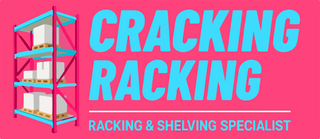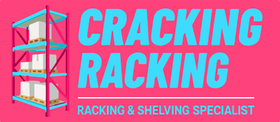What are rack safety inspections?
A rack safety inspection, sometimes known as a rack damage survey, is an assessment of the condition of your pallet racking, mezzanine floors, and other storage systems that could be at risk of damage during busy production hours. This could be from forklift trucks or material handling equipment for example.
A rack safety inspection should:
- Assess damage.
- Highlight areas where there is a risk of racking being damaged.
- Ensure your operation, and the racking systems are conforming to the local codes and legislation put in place.
- Help identify the racking load which is required for your racking under the legislation.
There are a number of levels of inspection which are required to be carried out at different intervals. Here at Cracking Racking, we have put together a guide as to what to expect and why rack safety inspections aim to minimise the risk, your business, and your employees.
Why should I have a rack safety inspection carried out?
 Not only is rack safety inspection required by UK legislation, but it also ensures your business is not affected by the possible consequences of racking collapse. If your racking is unsafe, damaged, or collapses this could cause a loss of stock, as well as injury, if not worse, to your staff.
Not only is rack safety inspection required by UK legislation, but it also ensures your business is not affected by the possible consequences of racking collapse. If your racking is unsafe, damaged, or collapses this could cause a loss of stock, as well as injury, if not worse, to your staff.
The Health and Safety Executive (HSE) states:
If you use pallet racking in your warehouse, you need to ensure the pallets you use are suitable for the type of racking you have.
Racking systems should be properly designed and installed, this includes being able to safely take the load of the goods being stored.
Protect racking if it is likely to be struck by lift trucks and other vehicles.
Inspect racking regularly to make sure it is repaired and maintained properly and is safe. You should use three types of inspection:
- Immediate reporting of damage and defects.
- Regular visual inspections.
- Expert inspections carried out at regular intervals by a competent inspector.
Check out the full HSE Warehouse and Storage Government documentation here.
Levels of inspection
The frequency of inspections depends on a variety of factors and these factors should be determined by a nominated person responsible for racking safety (PRRS) to suit the operating conditions of the warehouse.
A ‘Person Responsible For Rack Safety’ could be any person within a warehouse, who has experience in identifying racking damage.
The inspection will take into account the frequency and methods of operation within the dimensions of the warehouse, as well as the personnel involved and the equipment used, all of which could damage the structure.
As soon as an employee observes a safety problem or damage, it should be immediately reported to the PRRS. You should have a strategic system in place for reporting defects or damage.
Level 1 – Immediate Reporting
As soon as damage or safety problems are seen by an employee they must report it to the PRRS. Employees should know how to spot these problems from information and instructions provided by training on safe operations of the racking system. This should include the safety of themselves and others.
Employees should be encouraged to report damage and know they won’t be penalised because accidents can happen.
Level 2 – Visual Inspections
The PRRS should ensure that inspections are made regularly; weekly or other intervals based on risk assessment. A formal written record should be maintained.
Rack awareness training courses are available! Be sure to check they are SEMA approved!
Level 3 – Expert Inspections
A technically competent person should carry out inspections at intervals of not more than 12 months. A written report should be submitted to the PRRS with observations and proposals for any action necessary.
A technically competent person might be a trained specialist within an organisation, a specialist from the rack supplier, or an independent qualified rack inspector, such as a SEMA Approved Rack Inspector (SARI).
What’s an expert inspection and who can carry them out?
Even if you have worked in a warehouse for over 20 years and are responsible for new installations, it is important to recognise whether you have the specific skills to inspect racking at the industry recognised level of a SEMA Approved Racking Inspector (SARI).
SEMA = Storage Equipment Manufacturers Association.
SEMA is an industry trade association for racking manufacturers, they are committed to promoting and extending the safe installation, safe design and use of storage equipment.
Only an authorised inspection by a SARI or ‘SEMA Inspection’ is the industry recognised standard for racking inspections. These are the only reports then to be used as evidence of safe practice for the HSE.
An Expert SARI Inspection
An expert inspection conforms to the Storage Equipment Manufacturers Association (SEMA) “Guide to the Conduct of Pallet Racking and Shelving Surveys“. The guidelines assess damage to uprights, bracing members, and beams according to set tolerances.
A SARI inspection in much more in-depth inspection than a Level 2 inspection that you carry out weekly in your warehouse. It will address any necessary repairs, replacements, and damaged components according to the Storage Equipment Manufacturers Association (SEMA) Code of Practice relating to racking damage.
REMEMBER: Inspections are NOT a confirmation of structural integrity or guarantee of the capabilities of the racking.
SEMA classifies damage into three categories:
RED RISK: This is for items that are severely damaged well beyond the recommendations and SEMA code. If a red risk is given racking should be immediately off-loaded and isolated from future use until a satisfactory repair or replacement is put in its place.
AMBER RISK: This is when items are damaged beyond the limitations of the SEMA code, but not harmful enough to warrant immediate off-load. Instead, the rack should be off-loaded as soon as possible (up to 4 weeks), and should not be re-used until the repair work is completed.
GREEN RISK: This is for items that are damaged but are within the limitations of the SEMA code. These items need to be recorded as being suitable for use but must be identified for future reference and careful monitoring.
What are the racking inspection laws and legal requirements?
If you follow the racking inspection guideline your racking should conform with the major UK Health and Safety acts. This applies to shelve systems, cantilever racking, mezzanine floors, longspan shelving, and other storage equipment.
As an employer or person responsible for warehouse safety, you can be liable for prosecution under these acts:
- Provision & Use of Work Equipment Regulations (PUWER) 1998.
- Health & Safety at Work Act 1974.
- Management of Health & Safety at Work Regulations 1999.
- EN15635 Steel Static Storage Systems – Application and Maintenance of Storage Equipment.
Do I need a racking inspection?
Whether you’ve got 10 pallet positions or 10,000 you will need the same inspections from SEMA. HSE does not distinguish between the two. So regardless of size, height, or space, you need your storage systems inspection at least annually by a competent person.
Don’t forget it’s vital to carry out your own Level 2 inspections too!
Should I inform SEMA of racking changes in my warehouse?
No, as long as your racking is safely and securely assembled according to SEMA guidelines. If you’re keeping up to date with regular safety racking checks then you should be safe.
Do I need to be SEMA qualified to install racking?
While you will need SEMA qualified personnel to inspect your racking, you don’t need to be SEMA qualified to install it. What we do recommend is using installers that hold the Storage Equipment Installers Registration Scheme (SEIRS) qualification to install your pallet racking and storage systems. Pallet racking can cause serious accidents if not installed properly.
Does shelving require a SEMA inspection?
All storage equipment, including shelving, is classed as work equipment under the Provision and Use of Work Equipment Regulations (PUWER) 1998. Therefore, shelving does require regular inspection to ensure it is safe, particularly if it is in the vicinity of where materials handling equipment such as forklifts are used, mainly because the damage will be more common.
Does warehouse racking need a loading sign?
According to the Health and Safety Executive (HSE) and SEMA Guidelines, all racking systems are required to have a load notice. They must also be formatted to look like a typical SEMA load notice. If your pallet racking system doesn’t have a sufficient load notice then it is in breach of the law and your warehouse operatives will not know what load the racking is capable of taking. This is something your employees have an obligation to report should there not be one visible.
Make your workplace safer

As part of any industrial organisation, you have an obligation to put the Health and Safety of your employees at the forefront of your business model. If you’re always looking for ways to make your environment a safer place to be, we can help you minimise the likelihood of accidents here at Cracking Racking by exploring our safety and premises equipment and workshop and environment products.
If your rack safety inspection has run an amber or red risk, you may need to consider some new racking for your warehouse in order to pass your next inspection. Here at Cracking Racking, we specialise in shelving and racking solutions, that’s why you’ll find a comprehensive selection of racking systems and shelving systems, as well as used shelving, used long-span shelving, which makes a great addition to a whole host businesses environments; from small, independent retailers to large-scale warehouses, our racking is reliable, extremely sturdy and fabricated by our in-house team to your specifications.
Please contact our sales team if you need any assistance on 0161 330 1164 or email us at info@crackingracking.com.

